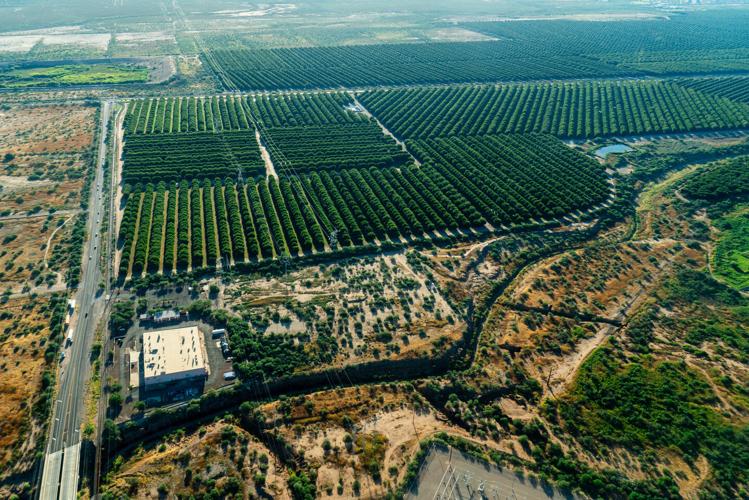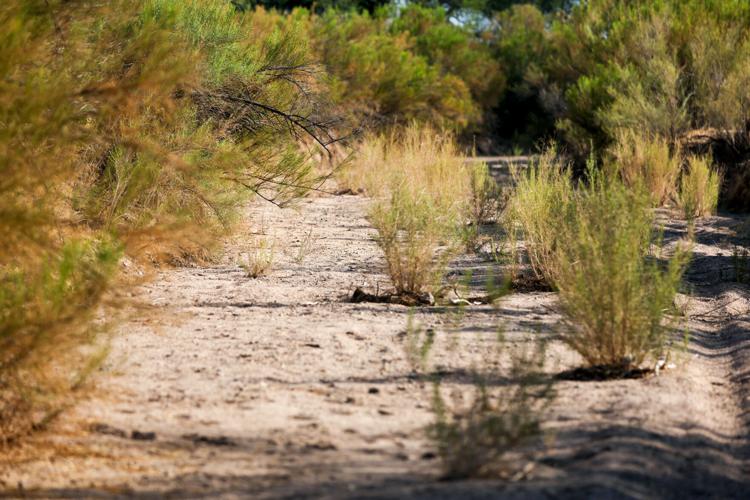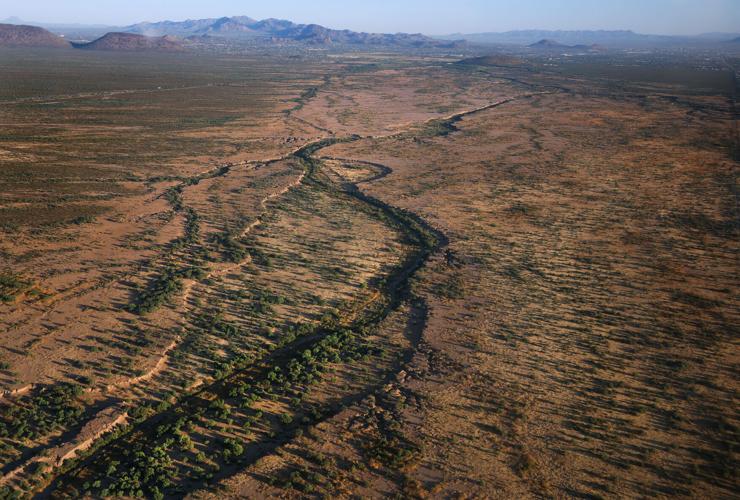A steady stream of water could one day flow along a dry stretch of the Santa Cruz River in Sahuarita, thanks to an effort by Pima County and a coalition of water managers and conservationists.
As early as next year, the county’s Green Valley Wastewater Treatment Facility could begin releasing some treated effluent into the riverbed, creating a modest brook stretching no more than about three-quarters of a mile near the Llano Grande Trailhead, about 25 miles south of ����ֱ��.
Ambitious future plans call for potential wastewater flows along more than 6 miles of the so-called Middle Santa Cruz, boosting the aquifer and the riparian corridor above it as the river winds past Sahuarita’s signature pecan groves east of Interstate 19.
“I’ve been wanting this project for many years, and I’m happy that more things continue to fall (into) place to make it a reality for the community and wildlife,” said Kimberly Baeza, permit and regulatory compliance officer with the .
People are also reading…
In February, the department applied for a state permit to begin releasing treated effluent from the Green Valley sewage plant into the riverbed as part of a so-called “instream recharge project.”
Baeza said the Green Valley plant is already permitted by the ����ֱ�� Department of Environmental Quality to release treated wastewater into the river channel.

An aerial photo from Sept. 24, 2024, shows a stretch of the Santa Cruz River in Sahuarita that advocates want to restore using effluent from a future Pima County wastewater treatment plant. The street on the left side of the photo is Pima Mine Road running east toward Nogales Highway.
The new permit the county is seeking would allow the plant to use the Santa Cruz as a recharge facility and earn full long-term storage credits for any wastewater it releases there.
Baeza said the county’s application is now under review by the ����ֱ�� Department of Water Resources, with a final permitting decision still “many months away.”
Putting recycled water into an otherwise dry stretch of river can have many “ecological and social benefits” beyond replenishing the aquifer, she said. The water releases could spur the growth of cottonwoods, willows, cattails and other native riparian plants, eventually creating what she called a “magnet for wildlife and wildlife watchers.”
Right now, all of the high-quality effluent produced by the Green Valley plant is sold to a nearby private groundwater recharge facility so master-planned developer can use it to ensure a long-term water supply for its Quail Creek retirement community in Sahuarita.
The remaining, lower-quality wastewater from the plant goes into an on-site recharge basin with “poor infiltration rates,” Baeza said in an email exchange. “This project will alleviate that by giving operators another place to recharge recycled water and accrue long-term storage credits for future use.”
Flow chart
Wastewater releases in Sahuarita have been in the works for more than five years now, said Luke Cole, director of the Santa Cruz River Program for the ����ֱ��-based nonprofit Sonoran Institute, a leader in watershed restoration efforts across the Western U.S. and northern Mexico.
In April, the Sonoran Institute released for the project, paid for with grant funding from the U.S. Bureau of Reclamation’s WaterSMART program.
The study looks at three conceptual scenarios for restoring the Middle Santa Cruz. The first would use the Green Valley plant’s modest surplus effluent volumes to produce surface flows that would peter out long before they reached Sahuarita’s Nogales Highway bridge over the river, about a mile downstream.
The second scenario would send all of the plant’s treated effluent into the Santa Cruz, creating 2.75 miles of flow, but not without the approved permit from state water regulators and an agreement from The Robson Companies to recharge the treated wastewater it’s buying from the county in the riverbed instead.
The third scenario, projected for as much as 20 years down the road, would tap into tens of millions of dollars in wastewater infrastructure that hasn’t been built yet to restore some 6.15 miles of the Santa Cruz through almost the entire length of Sahuarita.
Cole said the feasibility study was developed with research help and advice from the , a partnership launched in 2017 by agencies and organizations involved in water issues along the river in and around ����ֱ��.

This dry stretch of the Santa Cruz River off of Quail Crossing Boulevard in Sahuarita could become a steady stream some day as a result of proposed wasterwater releases by Pima County.
It’s hard to say when this stretch of Santa Cruz last had water in it, outside of isolated flood events. Cole said the bedrock is buried pretty deep in this area, so the river probably didn’t naturally flow aboveground all that often, even during wet years in the old days.
“That’s sort of what makes this opportunity all the more novel,” he said.
Restoration work
The Green Valley instream recharge project looks to build on the success of earlier restoration and recharge efforts along other stretches of the Santa Cruz.
Cole said water now regularly flows in separate segments that add up to roughly 40 miles of the river’s 90-mile course from the U.S.-Mexico border to its confluence with the Gila River just south of Phoenix.
The longest stretch starts at Pima County’s near El Camino Del Cerro and Interstate 10 and runs north for more than 20 miles to the Pinal County line and beyond, after gathering more treated effluent from the county’s Tres Ríos Water Reclamation Facility west of I-10 and Ina Road.
Cole said the Santa Cruz also flows for about 15 miles from Rio Rico almost to the Pima County line, thanks to a steady supply of effluent piped in from both sides of the border and cleaned at the Nogales International Wastewater Treatment Plant.
Meanwhile, the City of ����ֱ�� has created a mile or two of of its own, using groundwater treated for toxic contaminants at the plant near Irvington Road and reclaimed water released just south of the Starr Pass Boulevard bridge as part of the city’s .
The narrow ribbons of restored river in ����ֱ�� flow consistently enough to allow for the reintroduction of tiny native fish to the Santa Cruz in recent years.
Now, a growing coalition of local governments, community groups and environmental nonprofits are pushing for the establishment of a stretching from Mexico to Marana.

A view of the Santa Cruz River looking north toward ����ֱ�� during an EcoFlight aerial tour south of the city on Sept. 24, 2024.
And none of it would have been possible without a regionwide commitment — backed by about $2 billion in wastewater treatment improvements — to restore a flashy, desert river system using a byproduct of the very human developments that helped drain the Santa Cruz dry through ����ֱ�� .
“It was water that was otherwise being wasted. Now we’re doing something amazing with it,” Cole said. “We’re restoring an aquifer we depleted.”
Meanwhile, work continues farther upstream.
Using $550,000 in federal grant money, the Sonoran Institute has commissioned for future Santa Cruz restoration efforts between Nogales and Green Valley, as well as of the community and ecosystem benefits the river provides in Santa Cruz County.
Cole said there may be future opportunities to improve the health of the binational river — not to mention the people living near it on both sides of the border — through investments in water and sewer infrastructure in Mexico.
Such upgrades could “bear remarkable dividends,” he said, by improving sanitation for residents of Nogales, Sonora, while protecting the quantity and quality of the water that eventually makes its way downstream into Southern ����ֱ��.
‘Let her rip’
It won’t take much to introduce at least a little bit of flow to the Middle Santa Cruz in Sahuarita, Cole said. He thinks the releases there could start before the end of the year.
“The outflow for that Green Valley facility is right there in the river,” Cole said. “They could just open the hatch and let her rip.”
But Baeza said it’s not quite that simple.
Though the outfall pipe is already in place, the county would need to install a secondary treatment system to remove residual chlorine from the wastewater before it can be released into the river, she said. Current estimates suggest the dechlorination system could cost roughly $250,000 and take 6 to 12 months to design and build.
“At best we may have a permit by the end of 2025,” Baeza said, so the earliest any releases might start is in the summer of 2026, assuming county officials ultimately decide the instream recharge project is worth the investment.
Eventually, the county wants to replace the aging Green Valley plant altogether with a larger-capacity, regional wastewater facility now being planned near the intersection of Pima Mine Road and Nogales Highway.
Baeza said the new Sahuarita Treatment Facility is slated to be built and opened within the next five or six years at a preliminary cost of roughly $200 million.
Cole and others are hoping that project will include a dedicated pipeline running approximately 6 miles upstream, so recycled water from the new treatment facility can be pumped back to the Green Valley plant site and released into the river to sustain and expand what could be a nicely restored stretch of riparian habitat by then.
Asked about the pipeline idea, Baeza would only say that the new regional plant is still “in the early stages of development, and all options are being considered for the beneficial use of the treated effluent.”
But she wouldn’t be surprised to see at least some of that water wind up in the Santa Cruz.
“Our Pima County community places high value in flowing streams, as evidenced by investments in downstream river projects as well as upstream tributaries,” Baeza said.













